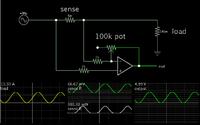
- Joined
- Apr 1, 2011
- Messages
- 15,569
- Helped
- 2,912
- Reputation
- 5,836
- Reaction score
- 3,047
- Trophy points
- 1,393
- Location
- Minneapolis, Minnesota, USA
- Activity points
- 116,614
Please help me out with this mosfet
Why does it have multiple sources and drains ?
The sources are connected to each other. The drains are connected to each other.
It gives a measure of heatsinking. The heat escapes more easily through several pins than through one.

